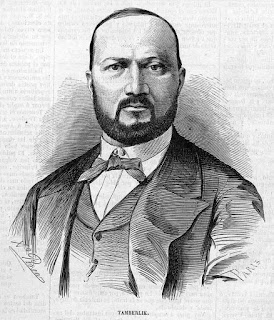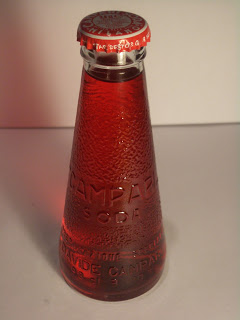NEW - Enrico Tamberlik – tenor
Imposing king of the high C sharp
Opera singer Enrico Tamberlik, who is remembered for the quality of his remarkable high notes, was born on this day in 1820 in Rome. At the height of his career, Tamberlik, whose name is also sometimes spelt Tamberlick, sang regularly at the Royal Opera House in London and in St Petersburg, Paris and America. The singer is believed to have been of Romanian descent but was born in Italy and did all his vocal training in Naples, Bologna and Milan. At the age of 17 Tamberlik made his debut in a concert and then made his first appearance on the operatic stage as Gennaro in Lucrezia Borgia by Gaetano Donizetti at the Teatro Apollo in Rome. In 1841 he appeared under the name Enrico Danieli at the Teatro Fondo in Naples as Tybalt in I Capuleti e I Montecchi by Vincenzo Bellini. A year later he made his debut at Teatro San Carlo in Naples under the name Enrico Tamberlik, which he used from then onwards. Tamberlik made his London debut as Masaniello in Louis Auber’s La Muette de Portici at Covent Garden in 1850. In St Petersburg in 1862 in the premiere performance of Giuseppe Verdi’s La forza del destino, he appeared as Don Alvaro, a role that had been written specially for him. Read more…
__________________________________________________________________
Aldo Moro - Italy's tragic former prime minister
Politician kidnapped and murdered by Red Brigades
Italy and the wider world were deeply shocked on this day in 1978 when the former Italian prime minister, Aldo Moro, was kidnapped on the streets of Rome in a violent ambush that claimed the lives of his five bodyguards. The attack took place on Via Mario Fani, a few minutes from Signor Moro's home in the Monte Mario area, at shortly after 9am during the morning rush hour. Moro, a 61-year-old Christian Democrat politician who had formed a total of five Italian governments, between 1963 and 1968 and again from 1974-76, was being driven to the Palazzo Montecitorio in central Rome for a session of the Chamber of Deputies. As the traffic forced Moro's car to pause outside a café, one of four small Fiat saloon cars used by the kidnappers reversed into a space in front of Moro's larger Fiat, in which the front seats were occupied by two carabinieri officers with Moro sitting behind them. Another of the kidnappers' Fiats pulled in behind the Alfa Romeo immediately following Moro's, which contained three more bodyguards. At that moment, four gunmen emerged from bushes close to the roadside and began firing automatic weapons. Read more…
__________________________________________________________________
Emilio Lunghi - athlete
Italy's first Olympic medallist
Emilio Lunghi, a middle-distance runner who was the first to win an Olympic medal in the colours of Italy, was born on this day in 1886 in Genoa. Competing in the 800 metres at the 1908 Olympic Games in London, Lunghi took the silver medal behind the American Mel Sheppard. In a fast-paced final, Lunghi's time was 1 minute 54.2 seconds, which was 1.8 seconds faster than the previous Olympic record buts still 1.4 seconds behind Sheppard. It was the same Olympics at which Lunghi's compatriot Dorando Pietri was controversially disqualified after coming home first in the marathon, when race officials took pity on him after he collapsed from exhaustion after entering the stadium and helped him across the line. A versatile athlete who raced successfully at distances from 400m up to 3,000m, Lunghi was national champion nine times in six events and is considered the first great star of Italian track and field. An all-round sportsman, Lunghi was a talented gymnast, swimmer and boxer, but after winning a 3,000m-race in his home city he was encouraged to develop his potential as a runner by joining Sport Pedestre Genova, at the time the most important athletics club in Liguria. Read more…
_________________________________________________________________
Bernardo Bertolucci - film director
Caused outrage with Last Tango in Paris
The controversial filmmaker Bernardo Bertolucci was born on this day in 1940 in Parma. Bertolucci won an Oscar for best director as The Last Emperor picked up an impressive nine Academy Awards in 1988 but tends to be remembered more for the furore that surrounded his 1972 movie Last Tango in Paris. Last Tango in Paris, starring Marlon Brando and Maria Schneider, caused outrage for its portrayal of sexual violence and emotional turmoil and was banned in Italy. Although the storm died down over time, it blew up again in 2007 when Schneider, who was only 19 when the film was shot, claimed she felt violated after one particularly graphic scene because she had not been told everything that would happen. Schneider died from cancer in 2011. The controversy has overshadowed what has otherwise been an outstanding career, his movies placing him in the company of Federico Fellini, Michelangelo Antonioni, Luchino Visconti and Franco Zeffirelli among the greatest Italian directors of all time. As a young man, Bertolucci wanted to become a poet, inspired by his father, Attilio, who was a poet as well as an art historian. Read more…
Home



























